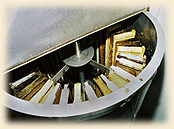The production and processing of honey

Honey begins as a tiny droplet of nectar (having only a very small sugar content) in a single flower. The offering of this sweet treat is nature's way of tricking the bee into visiting the flower as it carries the pollen grains of previously visited flowers, thus pollinating the flower. A honey bee may visit as many as 1500 flowers before her honey sac (completely separate from her digestive stomach) is full.

At this point, the weight of the nectar is a significant part of the bee's own weight. The worker bee laboriously makes her way back to the hive where she deliveries her precious cargo to younger hive bees who have not yet graduated to field duty. In the photo to the left, we see a frenzy of activity as returning field bees make their way into the inner sanctum of the hive.

Once inside the hive, the nectar is processed with enzymes and then deposited into hexagonal beeswax cells awaiting its final conversion into thick, golden viscous honey. This is accomplished by the "air conditioning" system the bees maintain within the hive. By the fanning of the wings of many thousands of bees, the nectar with an original water content of 80% is reduced to around 17%. Not all nectar is converted into honey. Some is consumed by the bees as food and some is converted into beeswax.

Beekeepers provide a "super" (box with frames) on top of the hive for the bees to store their surplus honey. The bees typically store more honey than they need to survive the coming winter. Here, we show a frame that has just been removed from a super. The bees have not yet completed filling this frame with honey since this is one of the outer frames. The inner frames are always filled first.

Finally, here is a completely filled frame of honey. Notice the layer of white "cappings" on the cells. This is the indication that the bees have finished with their evaporation of the excessive water content and that this is their finished product. This frame will yield about three pounds of honey.
At harvest time, full supers of honey are brought into the "honey house" for processing. As the frames are removed from the supers, they must be "uncapped". This is accomplished using a hot, sharp knife that slices off the thin layers of cappings. The cappings drop into a waiting receptacle where the honey inevitabally adhering to them is drained off. These cappings are later melted and poured into cakes which are, in turn, sold to industries that make use of this unique product.
At harvest time, full supers of honey are brought into the "honey house" for processing. As the frames are removed from the supers, they must be "uncapped". This is accomplished using a hot, sharp knife that slices off the thin layers of cappings. The cappings drop into a waiting receptacle where the honey inevitabally adhering to them is drained off. These cappings are later melted and poured into cakes which are, in turn, sold to industries that make use of this unique product.

The uncapped frames are now ready for the extractor. This machine is essentially a centrifuge that gently coaxes the honey out of the cells as it rotates. The empty frames are returned to the supers and ultimately returned to the bees. By giving the bees empty combs, they do not have to consume honey to build new combs (an estimated 6-8 pounds of honey must be consumed to produce a pound of wax) thus increasing the efficiency of honey production.

After striking the walls of the extractor, the honey flows to the bottom where it is picked up by a pump and delivered into large settling tanks. The extracting process traps tiny air bubbles in the honey and these (along with tiny bits of beeswax) rise to the top of the settling tank as a froth where they are skimmed off.
